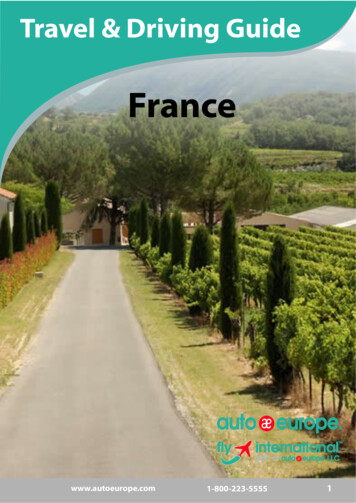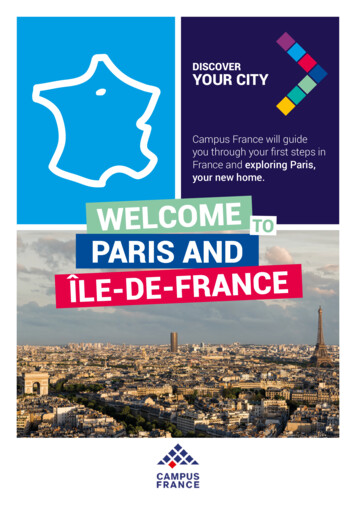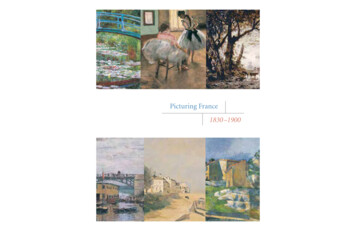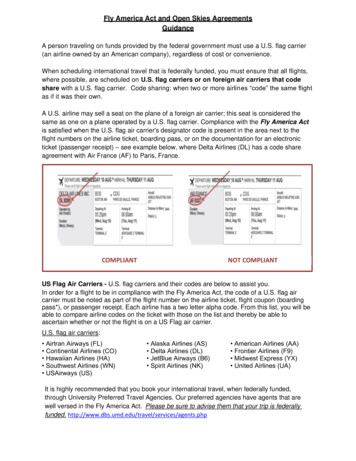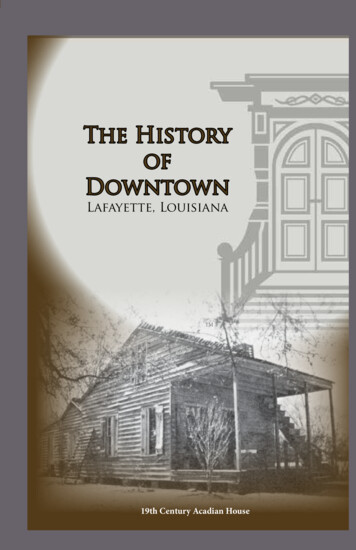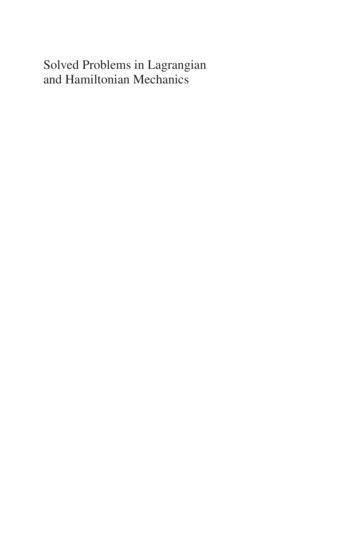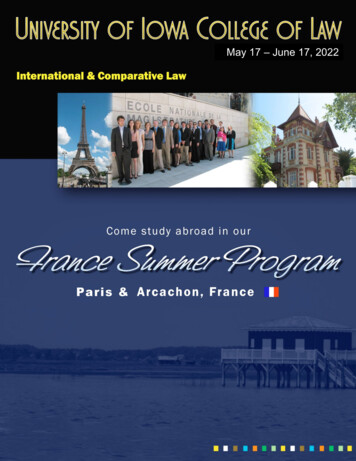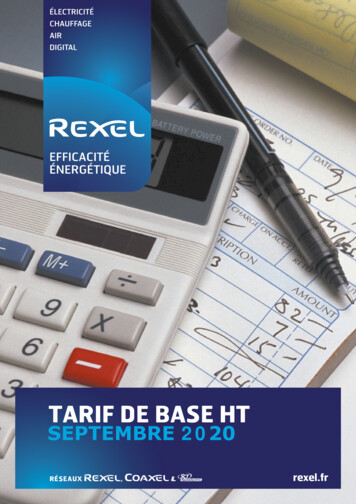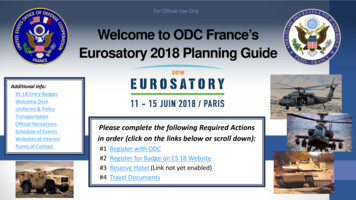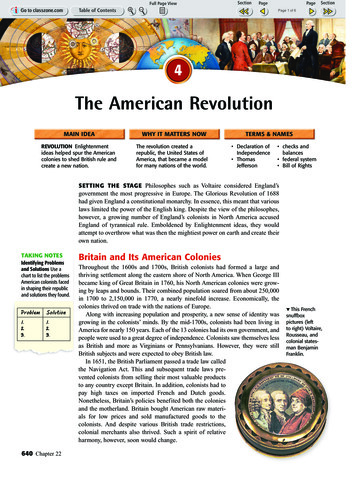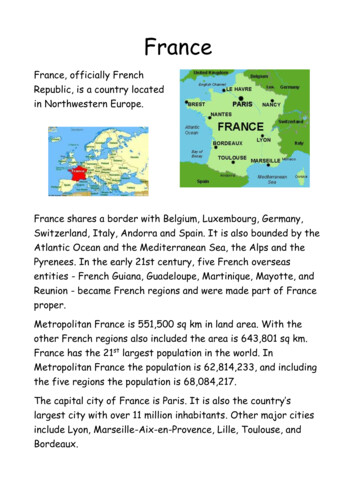
Transcription
FranceFrance, officially FrenchRepublic, is a country locatedin Northwestern Europe.France shares a border with Belgium, Luxembourg, Germany,Switzerland, Italy, Andorra and Spain. It is also bounded by theAtlantic Ocean and the Mediterranean Sea, the Alps and thePyrenees. In the early 21st century, five French overseasentities - French Guiana, Guadeloupe, Martinique, Mayotte, andReunion - became French regions and were made part of Franceproper.Metropolitan France is 551,500 sq km in land area. With theother French regions also included the area is 643,801 sq km.France has the 21st largest population in the world. InMetropolitan France the population is 62,814,233, and includingthe five regions the population is 68,084,217.The capital city of France is Paris. It is also the country’slargest city with over 11 million inhabitants. Other major citiesinclude Lyon, Marseille-Aix-en-Provence, Lille, Toulouse, andBordeaux.
FlagThe National Flag of France consists of three vertical stripesof equal width. They are blue, white and red and are known asthe “Le drapeau tricolore” (French Tricolor).The origin of the flag dates to 1790 and the French Revolutionwhen the “ancient French colour” of white was combined withthe blue and red colours of the Parisian militia; the official flagfor all French dependent areas.
PopulationPeople from France are French.French ,000,0004,000,0002,000,00000-14 years15-25 years25-54 yearsMale55-64 years65 years Female18.36% of people living in France are aged 0-14 years.11.88% of people living in France are aged 15-24 years.36.83% of people living in France are aged 25-54 years.12.47% of people living in France are aged 55-64 years.20.46% of people living in France are aged 65 years and over.
City Life81.2% of the population in France live in towns and cities.Paris is the capital city of France, and it is also the biggest city inthe country. Paris has many famous landmarks.Can you find the landmarks below on the map?Find out about another famous landmark shown on the map.
The Eiffel Tower: Built for Paris’ 1889’sWorld’s Fair, it has become the icon of the city.The Eiffel Tower is 312-meter high and is visiblefrom afar. There are two different routes toclimb the Eiffel Tower, you can use the elevator,or bravely go up the steps.The Notre Dame Cathedral:Construction began in 1163 andit took nearly two centuries tofinish it. Located in the historiccentre of Paris, with its hightowers, this cathedral inspiredauthor Victor Hugo for one ofhis novels - Notre Dame. Thesound of the bells will guide youto it.The Seine River: The best-knownriver in France, it flows from Dijonin the Alps to the English Channelat Le Havre. Running through theheart of Paris, the Seine is both amajor commercial river and abeautiful tourist attraction.Strolling along the banks or relaxing on a boat tour are lovely waysto view the city's monuments, historic buildings and ornate bridges.
Arc de Triomphe: One the biggest arches in the world, the Arc deTriomphe was built in 1806 tocelebrate NapoleonBonaparte’s victory inAusterlitz and was inspiredby the Roman triumphal arch.Beneath the vault is theTomb of the UnknownSoldier. An Eternal Flame is turned on each night at 6:30 p.m.Visitors can climb to the summit and enjoy a panoramic view of Paris.Basilica of the Sacré-Cœur:The Basilica of the Sacré-Coeuris on top of the hill ofMontmartre, and has amazingviews of Paris. Built in a RomanoByzantine style it is composed offour minor domes and a centraldome culminating at 83 meters. It also has a giant bell, one the biggestin the world. It was built in 1873 to commemorate the victims of the1871 war opposing France and Prussia.Louvre: The Louvrewas the palace of thekings of France. Todayit is a museum andallows you to discoveroccidental art fromMiddle Ages to 1848,as well as antiquecivilizations.
Centre Pompidou: The Centre Pompidou is an architectural wonder, a20th century building with afuturistic design. The outdoorescalators and the bigcolourful pipes make it an unmistakably uniquebuilding in Paris. The Centre includes theNational Museum of Modern Art and hostsvarious temporary art exhibits. There are different tributes todifferent arts, such as music, design, or cinema in the Centre. It isnamed after Georges Pompidou who was President of France from 1969to 1974 and wished to give French art a new place on the internationalstage.
French RegionsFrance is divided into eighteen administrative regions. Thirteenare located in metropolitan France, while the other five areoverseas regions.1. Auvergne-Rhône-Alpes2. Bourgogne-Franche-Comté3. Brittany4. Centre-Val de Loire5. Corsica6. French Guiana7. Grand Est8. Guadeloupe9. Hauts-de-France10. Île-de-France11. Martinique12. Mayotte13. Normandy14. Nouvelle-Aquitaine15. Occitanie16. Pays de la Loire17. Provence-Alpes-Côte d'Azur18. RéunionCan you identify which are the five overseas regions?
French RevolutionThe French Revolution was a period of time when the people of Francebrought down the king to overthrew the monarchy and also tookcontrol of the government.On July 14th 1789 the revolutionariesstormed a prison called the Bastilleand released prisoners that thegovernment had held there. This isconsidered to be the start of theFrench Revolution. The Revolutionlasted 10 years and saw Franceestablished as a Republic during thistime, though this did not last.In 1799 the French Revolution ended when a young general namedNapoleon Bonaparte overthrew the revolutionary government. He madehimself the leader of a new governmentcalled the Consulate. Napoleon grew sopowerful that in 1804 he declaredhimself Napoleon I, emperor of France.Emperors and kings ruled France formost of the next 70 years. Francebecame a republic again in 1871.The social and political structures of France were completely changedby the French Revolution. It put an end to the monarchy, feudalism,and took political power from the Catholic church. It brought newideas including liberty and freedom for the commoner to Europe, aswell as the abolishment of slavery and the rights of women. Therevolution ended with the rise of Napoleon, but the ideas and reformsdid not die. These new ideas continued to influence Europe and havehelped to shape many of Europe's modern-day governments.
Bastille DayBastille Day is the name commonly given in English-speakingcountries to the national day of France, which is celebrated on 14July each year. In French, it is formally called Fête nationalefrançaise, and legally is le 14 juillet.It is the anniversary of the Storming of the Bastille on 14 July1789, a major event of the French Revolution, as well asanniversary of the Fête de la Fédération that celebrated theunity of the French people on 14 July 1790.From the first celebrations of this national day, speeches,military parades, and fireworks, along with public revelry, werepart of the celebration. The slogan “Vive le 14 juillet!” (“Long livethe 14th of July!”) has continued to be associated with the day.In Paris, the traditional military parade on the Champs-Elysées isa meticulously planned spectacle. Dancing and firework displays orilluminations are organized across the whole country.
French CultureFrench Values: French traditions and culture reflect the Frenchvalues of unity, beauty, respect, and family. TheFrench motto “Liberty, Equality, and Fraternity”reflects these values. Equality and unity areimportant to the French. The French also value styleand sophistication, and they take pride in the beautyand artistry of their country.Family: Family is highly valued in French culture. The family has beenthe founding unit of French society for generations. Traditionally, thefamily structure could include either extended or nuclear families.Cuisine: Meals in France are meant to be enjoyed. Food is made withgreat care, and mealtimes are a prime time for socializing. While Frenchcooking is recognized around the world, there are many varieties incooking styles, ingredients, and dishes from region to region.Fashion: French style can be describedas sophisticated and fashionable. Paris isoften regarded as the fashion capital ofthe world and is home to worldwidebrands such as Louis Vuitton and Chanel.It was in the 1600s during the reign ofLouis XIV that France became a major influencer in fashion becomingknown for its luxury goods throughout Europe.Arts and Media: French literature,painting, and cinema are all historicallysignificant around the world. Works such asLes Misérables, or artists such as Monet aresome of the most recognizable in the world.Art is highly regarded in France and The
Louvre, in Paris, is the largest art museum in the world. In France you’llalso see artists painting in the streets.Greetings: Kissing on the left and thenright cheek is a common informal greetingfor woman-to-man, woman-to-woman, orman-to-woman interactions. For man-toman interactions though, or formalsettings, handshakes are common. Whengetting someone’s attention, start bysaying “Bonjour Madame/Monsieur”If you’re ever uncertain how to behave while in France, observe whatlocals do. Mimicking the behaviours of French locals will help you remainpolite and respectful to their culture and traditions.Some helpful tips include: Shoppers bag their own food at grocery stores.If you speak English, first ask someone if they speak English beforeyou actually speak to them in English.It is polite to be formal and reserved, particularly with strangersor acquaintances.Quiet tones are expected in public.“Dressing down” is not common in France. Drinks are served at room temperature rather than cold or with ice.If invited into a French home, it’s customary to bring a small gift such as chocolates, flowers, or candies.Appetizers are served with most meals, so don’t fill up before the main dish is served.To know when to start eating or how to eat certain foods, observe what the host does.Keep both hands at the table while eating, but keep your elbows offthe table.
FoodTraditional French cuisine (food) ischaracterized by its cheeses, wines,breads, and sauces.Breakfast is typically light: a Frenchpastry, typically a croissant, or bread,served with a hot beverage of hotchocolate or coffee. Lunch and dinner are considered to be the mainmeals of the day. Formal meals will have four courses: a starter, asalad, a main course, and a cheese or dessert course.French bakeries - ‘boulangeries’ and ‘patisseries’, are very common,and they are well-known for delicious pastries. These are sweet,baked desserts, often made with fruit or chocolate.Some typical French foods include:Crêpes: (pronounced with a short 'e' sound,like 'step') A thin pancake made with flour,eggs, milk, and sugar. It is cooked on bothsides and then stuffed with fillings like sweetcream or fruit.Pain au chocolat: This literally means'bread with chocolate'. It is cuboid shapedand has one or two pieces of dark chocolatein the centre. It is often sold still hot orwarm from the oven.Croissants: A crescent-shaped roll madeof sweet flaky yeast dough, eaten forbreakfast in France. The dough istypically layered with butter, then rolled,
and folded several times. The final dough is cut into triangles androlled into a crescent shape. It is originally from Austria but nowassociated with France.Baguette: A long, thin type of bread with a crispcrust. A baguette has a diameter of about 5 to 6centimetres and a usual length of about 65 cm,although a baguette can be up to 1 m long.French cheese: A well-stocked cheese board is an important part ofFrench cuisine. Every region of France has itsown particular cheeses. Back in the time ofGeneral de Gaulle, France had 246 cheeses - andit has quite a few more than that now. Frenchcheeses can be divided into three main families:pressed cheeses (like most British cheeses); softcheeses, such as Camembert; and blue cheeses.Truffles: Truffles are a rare and delicate type ofedible mushrooms that look like little potato nuggets.They grow just under the ground.Salade Nicoise: A salad made with tuna, greenbeans, hard boiled eggs, tomatoes, andpotatoes. It originated in the French city ofNice.Ratatouille: A classic end-of-summer French stewthat's packed with fresh produce: tomatoes, garlic,onion, aubergine, courgette, marrow, peppers, and acombination of leafy green herbs.Quiche Lorraine: Quiche is a French tartconsisting of pastry crust filled with savourycustard and pieces of cheese, meat, seafood orvegetables. The best-known type is ‘Quiche
Lorraine’, which includes lardons or bacon. Quiche canbe served hot or cold.Cassoulet: A rich, slow-cooked casserole containingmeat, pork skin and white beans. Originating in southernFrance, it is a medieval peasant dish designed to usewhatever was around.Frog legs: Exactly what they sound like: the legsof an edible frog. The meat can be stewed, fried,grilled, or stir-fried. Frog legs have a flavour andtexture that's similar to a combination of chickenand fish.Crème brûlée: A creamy, pudding-like,baked custard with a brittle top of meltedsugar that cracks when you gently tap it witha spoon. It should be brûléed (torched) rightbefore it is served.Macarons: A meringue-based sandwich cookiemade with almond flour, egg whites, confectioners'sugar, and food colouring. It is both elegant anddelicate as well as delicious.Tarte Tatin: Named after the Tatin sisters who invented it andserved it in their hotel as its signature dish,it is a pastry in which the fruit iscaramelized in butter and sugar before thetart is baked.Challenges:- How many of these French foods have you eaten?- Create yourself a menu for a day of French foods.
Wine MakingFrance is the epicentre of the wine world.Of all the countries in the world, France consumes the secondlargest amount of wine. In total, the French consumeapproximately 25 million hectolitres per year. They are secondto the United States, which consumes about 30 millionhectolitres.In addition to consuming a lot of wine,France is also known for creating wine,including some of the most expensivewine in the world. Some bottles of winecan cost around 21,000!French wine is produced all throughout France and is sold allacross the world. Here are some of the most popular Frenchregions for wine: Burgundy Bordeaux Rhode Valley Provence (close toMarseille) Champagne
The Alps & PyreneesFrance has borders of water ormountain on almost all sides.The Alps and the Pyrenees aremajor mountain ranges inEurope, and both ranges runalong the borders of France.The Alps:The word 'alp' comes from the Latin term for albus, whichmeans white. We often think of the Alps with white, snowymountain peaks. The Alps are Europe's tallest and youngestmountain range.The Alps create a shape like a crescent moon, extending fromthe coast of southern France toward Switzerland, Austria, andnorthern Italy, and thenrounding their way downSlovenia to the Adriatic Sea.The Alps are about 750 milesin length. The tallest peak isMont Blanc at 15,781 feet,which is situated in bothFrance and Italy.
The Pyrenees:Did you know there is a tinylittle country called Andorranestled in between France andSpain? It sits here because thePyrenees Mountains form anatural wall between the two countries. Andorra got caught inthe middle!Unlike the Alps, the Pyreneesare an old mountain range. Theyextend from the MediterraneanSea westward all the way to theAtlantic Ocean, covering a totalof about 270 miles.Both the Alps and the Pyrenees arepopular alpine resorts with fantastic skislopes.During the summer these same slopesare popular with hikers and cyclists.
French Sporting EventsTour de FranceA world-famous cycling event. Nearly 200 cyclists race over 2,000miles in just 23 days. During the 23 days the cyclists race 21 daylong segments (stages). All of the stages are timed to the finish; theriders' times are combined with their previous stage times and therider with the lowest cumulative finishing times is the leader of therace and wears the yellow jersey.Every year the course changes,travelling through the best of thecountryside, mountains, towns andcities of France. The cycle pelotonneeds to show superhuman strength,endurance and skill on this gruellingcourse.Roland-GarrosThe French Open, also known asRoland-Garros, is a major tennistournament held over two weeks inParis, beginning in late May eachyear. The tournament and venue arenamed after the French aviatorRoland Garros. The tournament isone of four Grand slam events (or Majors) throughout the tenniscalendar. The event is famous for its red coloured clay courts.The tennis player with the most wins at this event is Rafael Nadal(Spanish), who has won the men’s singles titles 13 times so far!
French Grand PrixThe French Grand Prix, formerlyknown as the Grand Prix de l'ACF, isa car race held as part of theFédération Internationale del'Automobile's annual Formula OneWorld Championship. Based in thesouth of France, it is one of the oldest motor races in the world aswell as the first "Grand Prix" havingfirst been held in 1906. It has sincebeen held 88 times. The circuitlength is 3.63 miles (5.842 km) anddrivers need to complete 53 laps ofthe circuit.The driver with the most wins at this race is Michael Schumacher(German) with a total of 8 wins between 1994 and 2006.The Evian ChampionshipThe Evian Championship is awomen's professional golftournament in France, playedat the Evian Resort Golf Clubin Évian-les-Bains. It is oneof the five women’s golfGrand Slam tournaments.
Paris Olympics 2024The next summer Olympics andParalympic games will be held in Paris in2024. It is set to take place exactly 100years after France’s last summerGames. This will be the Games of the33rd Olympiad. Paris 2024 will be thelargest event ever organised in thecountry, running from Friday 26 Julyuntil Sunday 11 August 2024.At this event another new dynamic sport will be added to the Parisline-up: breaking, a competitive form of breakdancing. This bringsthe official number of Olympic sports to 32.In the spirit of reconnecting communities and sharing the Gameswith as many people as possible, Paris 2024 will also be the first inOlympic history to include apublic version of the marathonand road cycling events, wheremembers of the public can applyto follow in the athletes’footsteps on the same day andcourse as the medal races.
Money - EurosThe Euro is the official currency in France. Euros replaced thefrench franc as national currency in 2002.The euro is represented by the symbol . One euro is made upof 100 cents. Coins are minted in denominations of 1, 2, 5, 10, 20and 50 cents, and 1 and 2 euros. Milled edges on the coins makeit easier for the visually impaired to recognise different values.When referring to money the French have their own slang whichthey might use. For example, une balle when referring to moneymeans a euro, and le sou can be used to refer to money in ageneral sense, but more often to les centimes (cents, money lessthan one euro).
Traditional CostumeOne the most typical items of clothingassociated with the French is the blackberet. It is still worn by some men,particularly in rural areas. Caricatures ofFrench men often show them in a blackberet with a blue striped top, with amoustache and a string of onions orgarlic around their neck, or holdingbaguettes and / or wine.This caricature of the French male is down to a few so-called "OnionJohnnies" who used to pedal round Britain selling Roscoff onions.Not really representative of an entire nation.------Traditional costumes are regional and differ across the country.For example, In Alsace, women may be seen inwhite, lace-trimmed blouses and aprons decoratedwith colourful flowers. In Normandy, women'scostumes include white, flared bonnets anddresses with wide, elbow-length sleeves.Bretons, from the Brittanyregion, costumes include broadbrimmed hats, embroideredwaistcoats (vests), and short jackets for the men.Women wear dresses and elaborately decoratedaprons. The most distinctive feature of thewomen's costume is the elaborate lace headgear,which is generally called a coiffe (kwaff).
Louis BrailleLouis Braille (1809-1852),was a French educator andinventor.He created the "BrailleCode", the writing andreading system used by blindor sight impaired people. Thecode consists of little dotsrepresenting letters. His system remains virtually unchanged tothis day, and is known worldwide simply as braille.Louis Braille had lost his eyesight as a young boy, heexperimented and improved his writing system and later becamea teacher, musician and researcher.The Braille AlphabetChallenge: Write your name in Braille
Famous French CharactersAsterix and Obelix, the stories of thefamous Gaules fighting the Romans are read bypeople all over the world. The characters werecreated and designed in 1959 by the twoFrench artists René Goscinny (1926-1977) andAlbert Uderzo (1927-2020).Le Petit Nicholas, the stories of the 'Little Nicholas' by JeanJacques Sempé (born 1932) and René Goscinny were published in1959 and tell about the typical childhood stories of those times.The Little Prince, in French 'Le Petit Prince' byAuguste de Saint-Exupery (1900-1944), is a famouschildren's story about a pilot who meets a princefallen from onto earth. The little prince observesand comments his experiences in this heartwarmingstory. The most famous words are: 'One seesclearly only with the heart. What is essential isinvisible to the eyes.'The Hunchback of Notre-Dame, the famous animated film byWalt Disney, is based on the original classicstory by Victor Hugo (1802-1885). The maincharacters are Quasimodo, a kind but isolatedyoung man with an overly curved deformedspine who lives inside the cathedral.The Three Musketeers, are a famousadventure story written by French author Alexandre Dumas (18021870) in 1844. French D'Artagnan meets the three musketeersAthos, Aramis and Porthos during his travels from Gascony to Paris.
France – Fun Facts France is the most-visited country in theworld. Approximately 89 million people visitFrance every year. France isn’t that big, but it is the biggestcountry in the European Union. France is twiceas big as the United Kingdom. The French say "ooh lá lá" when they are impressed. You mighthear the expression when someone eats a particularly tastypiece of cheese, or sees someone do something really good. In France over 25,000 tons of snails are eaten every singleyear. On average, a resident of France eats approximately 500snails per year, commonly cooked in butter and garlic. TheFrench consider snails to be a delicacy Snails are referred toas “escargot”. France produces over 1,500 types of cheese. Supermarkets in France are not allowed to throw away foodthat is near the “best by” date. Instead, they must donate thefood to a charity or food bank. France passed this law in 2016to help reduce hunger and prevent food waste! One French king only held the throne for about 20 minutes.This was one of the shortest reigns of a monarch that therehas ever been. His father abdicated (renounced his throne)making him king. About 20 minutes later Louis XIX alsoabdicated. The French invented camouflage during World War I in 1915.They hired artists to paint both their vehicles and their gunsso that they would blend in with the environment around them. The French believe that placing a baguette (or any type ofbread) upside down on a table can cause bad luck.
City Life 81.2% of the population in France live in towns and cities. Paris is the capital city of France, and it is also the biggest city in the country. Paris has many famous landmarks. Can you find the landmarks below on t
